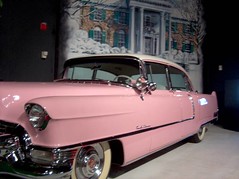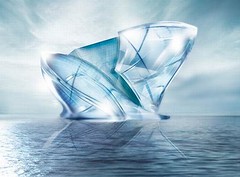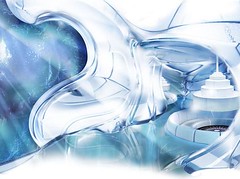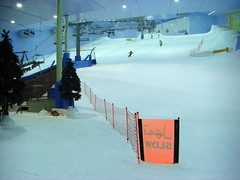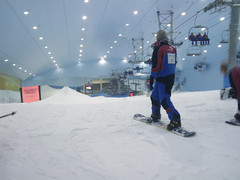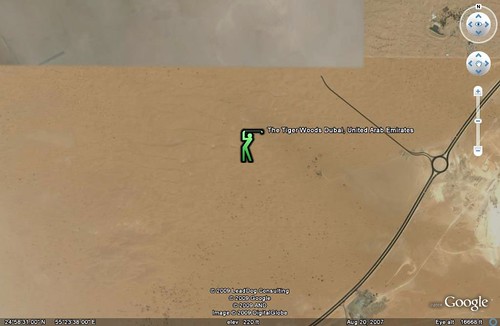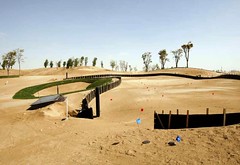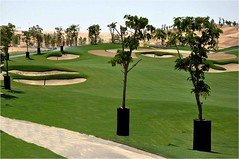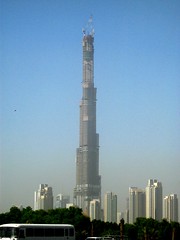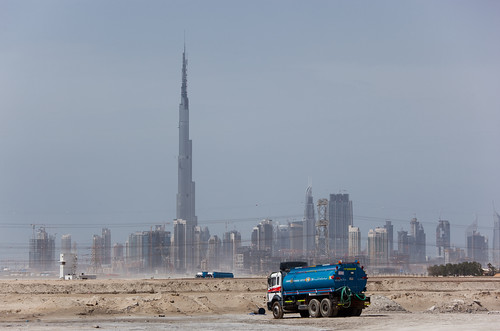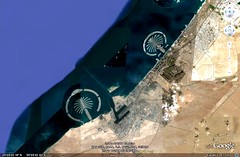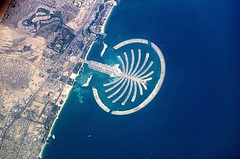Vegas on steroids: meet Dubai

Posted September 23, 2009 at 1:17PM
For me, a post about Dubai (the amazing pace of construction shown above) must begin with some thoughts about Las Vegas and about the king of rock'n'roll, who performed in that city often and whose impersonators there remain legion. It's all connected, really.
When I think of Las Vegas, I think of Elvis, but not so much his shows there or the cheesy-if-sometimes-fun impersonators. Instead, I think of his pink Cadillacs. I am dating myself: I am old enough to remember when Elvis (Presley, not Mr. McManus) was in his prime and, having grown up a poor white boy in Mississippi by way of Tennessee (a background not unlike my own), one of the first things he did when he had real money was to buy a screaming pink Cadillac. The first one was soon followed by others. There was nothing subtle or restrained about Elvis's desire to show the world, as extravagantly as possible in those times, that he had made it.
It's an understandable impulse. Vegas, in its way, embodies it. Recently America's fastest growing metro area, and certainly one of its most sprawling, the city of conspicuous consumption in the improbable location of a dry, hot desert, is a place to dream big, shout loud, and spend extravagantly. Understated (or environmentally sensible) it is not. It's Vegas, baby.
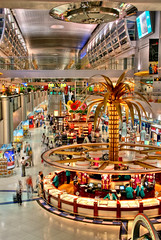 But Vegas has nothing on Dubai. The most populous city in the United Arab Emirates, Dubai is another rapidly growing, water- and oil-consuming city in a desert, one that has taken the pink-Cadillac, flashy Vegas aspiration to a new extreme that Elvis couldn't possibly imagine. Dubai may be the most environmentally unsustainable place on earth, certainly among the most conspicuously extravagant, and reportedly with the world's highest per-capita rate of natural resource consumption. But it is definitely not boring. I'm actually a little fascinated by it.
But Vegas has nothing on Dubai. The most populous city in the United Arab Emirates, Dubai is another rapidly growing, water- and oil-consuming city in a desert, one that has taken the pink-Cadillac, flashy Vegas aspiration to a new extreme that Elvis couldn't possibly imagine. Dubai may be the most environmentally unsustainable place on earth, certainly among the most conspicuously extravagant, and reportedly with the world's highest per-capita rate of natural resource consumption. But it is definitely not boring. I'm actually a little fascinated by it.
Regular readers may remember my post from last year, highlighting a hotel with a refrigerated beach. Turns out that was just the tip of the iceberg, so to speak, because now this city with average temperatures over 90 degrees F. for over half the year (and 100+ average for four months per year!) is slated also to get a year-round floating ice hotel:
That's the lounge depicted in the right image. Alexandra Kain dryly (heh) notes in Inhabitat that "Dubai's arid desert climate doesn't easily lend it to ice sculptures - especially not ones with 6 stories of luxury entertainment including an underwater lounge and ballroom." And, oh yeah, Kain also reports that the hotel's backers claim it will be sustainable, off the grid and such. Sure.
But Dubai's fascination with wintry places doesn't stop with the ice hotel. There are also the indoor ski slopes:
Note the chair lift in the left photo. Ski Dubai, naturally, is part of one the world's largest shopping malls. Its temperature is maintained at -1 C. during the day and -6 C. at night, when the snow is produced.
Dubai gets about 6 inches of rain per year, or less than one-fifth of what Dallas gets. Yet there's a Tiger Woods Dubai golf course, whose lush fairways and greens reportedly require four million gallons of water every day: Below are the golf club's desert location, noted on a Google Earth image from before construction began, and a couple of before and after photos:
It is but one of ten grassy golf courses in Dubai.
A bit of water is also required by the world's tallest (by far) man-made structure, the incredibly huge Burj Dubai, standing at some 164 stories and visible from 95 kilometers away. The first two photos of the building under construction, below, were taken in 2007 and 2009, respectively. And note how it soars above the fog in the third, amazing photo taken by Mohamed Somji at the end of 2008:
It is certainly an impressive structure. According to its web site, "15 million gallons of water, or about 20 Olympic sized swimming pools, are required for the tower's use. The cooling requirements of the Burj Dubai are equivalent to about 10,000 tons of melting ice." It is scheduled to be ready for occupancy later this year and will house around 35,000 people at any one time.
But wait, there's more: How about a couple of man-made islands, shaped like palm trees?
The photo on the left is a satellite image from Google Earth. The one on the right was taken from the International Space Station. Constructing the Palm Islands has been a daunting task, to say the least, and there has even been a rumor that the first one developed, Palm Jumeira (right photo), is sinking, though to my knowledge that has not been reported as fact. The Toronto Star's Christopher Hume refers to Dubai, addicted to superlatives, choked by traffic, massively unfriendly to pedestrians, and based on an economy built on a dwindling resource, as a "ruin-in-waiting."
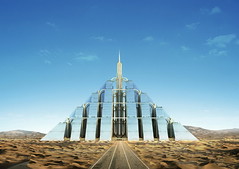 With all this extravagant trendiness, I suppose it shouldn't surprise that some of the pink-Cadillac thinking is now being directed toward "sustainability." Behold a giant city-in-a-pyramid called Ziggurat, which will have a literal footprint of 2.3 square kilometers, house one million inhabitants, and supposedly be carbon-neutral. Evelyn Lee reports in Inhabitat that its designers claim "Ziggurat will be capable of running completely off the grid by utilizing steam, wind, and other natural resources. The tightly knit city will also feature a super efficient public transportation system that runs both horizontally and vertically, and plans are being drawn up to utilize both public and private green spaces for agricultural opportunities."
With all this extravagant trendiness, I suppose it shouldn't surprise that some of the pink-Cadillac thinking is now being directed toward "sustainability." Behold a giant city-in-a-pyramid called Ziggurat, which will have a literal footprint of 2.3 square kilometers, house one million inhabitants, and supposedly be carbon-neutral. Evelyn Lee reports in Inhabitat that its designers claim "Ziggurat will be capable of running completely off the grid by utilizing steam, wind, and other natural resources. The tightly knit city will also feature a super efficient public transportation system that runs both horizontally and vertically, and plans are being drawn up to utilize both public and private green spaces for agricultural opportunities."
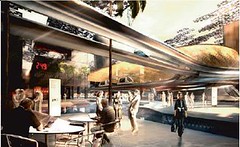 Another extravagant and futuristically designed environmental undertaking, Masdar City is a "green community" already being constructed some 60 miles from Dubai and just outside of Abu Dhabi, Dubai's more conservative cousin (and the UAE capital). Masdar will be a walled city occupying 6.5 square miles and designed (somewhat modestly in comparison to Ziggurat) to house 50,000 inhabitants, eventually growing to 100,000. It will be linked to existing Abu Dhabi by high-speed rail and be internally car-free. The investment web site Overseas Property Mall reports the new city's environmental ambitions:
Another extravagant and futuristically designed environmental undertaking, Masdar City is a "green community" already being constructed some 60 miles from Dubai and just outside of Abu Dhabi, Dubai's more conservative cousin (and the UAE capital). Masdar will be a walled city occupying 6.5 square miles and designed (somewhat modestly in comparison to Ziggurat) to house 50,000 inhabitants, eventually growing to 100,000. It will be linked to existing Abu Dhabi by high-speed rail and be internally car-free. The investment web site Overseas Property Mall reports the new city's environmental ambitions:
"Some key targets of the project include: 100 per cent of energy supplied by renewable energy - solar power, wind, waste to energy and other technologies to create a zero-carbon environment; 99% diversion of waste from landfill (includes waste reduction measures, re-use of waste wherever possible, recycling, composting, waste to energy) in the hope of producing zero waste; Zero carbon emissions from transport within the city and measures to reduce the carbon cost of journeys to the city; using recycled materials for building; using 50% less water than a typical city."
While no one can argue with those goals, I can't help but wish that all that design, ambition and money were being applied to an environmental retrofit of the various ecological disasters already committed by Dubai and the UAE in the desert, rather than to yet another shiny new project designed to impress. But that doesn't seem to be the way things are done in the UAE. New money apparently doesn't flow merely toward making things better, whether we are in the Memphis of Elvis's day, the Las Vegas of the 1990s, or the Dubai of the 21st century.

